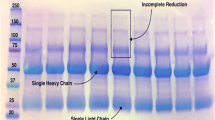Abstract
Glycodelin-A belongs to the lipocalin superfamily. Although it is associated with normal endometrial growth during the menstrual cycle, fertilization and normal pregnancy in humans, the molecular mechanism of its biological action has not been elucidated. To undertake studies to understand the functional relevance of any molecule, obtaining large quantities of the protein becomes essential. With the ultimate aim of purifying glycodelin either from its natural sources (human amniotic fluid) or the recombinant glycodelin from bacterial recombinant lysates, we raised monoclonal antibodies to this protein. As immunogens, recombinant glycodelin expressed in E. coli and Pichia pastoris as well as glycodelin from amniotic fluid were used. The monoclonal antibodies generated were characterized with respect to binding to both the native as well as the recombinant proteins using ELISA, immunoblotting, and immunohistochemistry.
Similar content being viewed by others
References
Bell SC, Bohn H (1986) Immunochemical and biochemical relationship between human pregnancy-associated secreted endometrial α1-and α2-globulins (α1-and α2-PEG) and the soluble placental proteins 12 and 14 (PP12 and PP14). Placenta 7: 283-294.
Bohn H, Kraus W, Winckler W (1982) New soluble placental proteins; their isolation, characterization, localization and quantification. In: Klopper A ed., Immunology of Human Placental Proteins. Placenta. East-bourne: Praeger Suppl. 4, pp. 67-81.
Boulard Ch, Lecrousey A (1982) Specific antisera produced by direct immunization with slices of polyacrylamide gel containing small amounts of protein. J Immunol Meth 50: 221-226.
Chryssikopoulos A, Mantzavinos T, Kanakas N, Karagouni E, Dotsika E, Zourlas PA (1996) Correlation of serum and follicular fluid concentrations of placental protein 14 and CA-125 in in vitro fertilizationembryo transfer patients. Fertil Steril 66: 599-603.
Dell A, Morris HR, Easton R, Panico M, Patankar M, Oehninger S, Koistinen R, Koistinen H, Seppala M, Clark GF (1995) Structural analysis of the oligosaccharides derived from glycodelin, a human glycoprotein with potent immunosuppressive and contraceptive activities. J Biol Chem 270: 24116-24126.
Dutta B, Mukhopadhyay D, Roy N, Das G, Karande AA (1998) Cloning, expression, purification, and immunocharacterization of placental protein-14. Protein Expr Purif 14: 327-334.
Julkunen M, Apter D, Seppala M, Stenman UH, Bohn H (1986a) Serum levels of placental protein 14 reflect ovulation in nonconceptional menstrual cycles. Fertil Steril 45: 47-50.
Julkunen M, Koistinen R, Suikkarri AM, Seppala M, Janne OA (1986b) Secretory endometrium synthesizes placental protein 14. Endocrinology 118: 1782-1786.
Julkunen M, Rutanen EM, Koskimies AI, Ranta T, Bohn H, Seppala M (1985) Distribution of placental protein 14 in tissues and body fluids during pregnancy. Br J Obstet Gynaecol 92: 1145-1151.
Julkunen M, Seppala M, Janne OA (1988) Complete amino acid sequence of human placental protein 14: A progesterone-regulated uterine protein homologous to beta lactoglobulins. Proc Natl Acad Sci 85: 8845-8849.
Julkunen M, Wahlstrom T, Seppala M (1986c) Human fallopian tube contains placental protein 14. Am J Obstet Gynecol 154: 1076-1079.
Kamarainen M, Haltunnen M, Koistinen R, Von Boguslawsky K, Von Smitten K, Andersson LC, Seppala M(1999) Expression of glycodelin in human breast and breast cancer. Int J Cancer 10: 738-742.
Kamarainen M, Leivo I, Koistinen R, Julkunen M, Karvonen U, Rutanen EM, Seppala M (1996) Normal human ovary and ovarian tumors express glycodelin, a glycoprotein with immunosuppressive and contraceptive properties. Am J Pathol 148: 1435-1443.
Klentzeris LD, Bulmer JN, Seppala M, Li TC, Warren MA, Cooke ID, et al. (1994) Placental protein 14 in cycles with normal and retarded endometrial differentiation. Hum Reprod 9: 394-398.
Kohler G, Milstein C (1975) Continuous cultures of fused cells secreting antibody of predefined specificity. Nature 256: 495-497.
Kumar Reddy MMM, Karande AA, Adiga PR (1992) A ommon epitope of β-lactoglobulin and serum retinol binding proteins: Elucidation of its core sequence using synthetic peptides. Mol Immunol 4: 511-516.
Litvinov SV, Velders MP, Bakkerr HAM, Fleuren GJ, Warnaar SO (1994) Ep-CAM: A human epithelial antigen is a homophilic cell-cell adhesion molecule. J Cell Biol 125: 437-446.
Macdonald PN, Ong DE (1988) Binding specificities of cellular retinolbinding protein and cellular retinol-binding protein, type II. J Biol Chem 262: 10550-10556.
Morrow DM, Xiong N, Getty R, Ratajczak MZ, Morgan D, Seppala M, Riittinen L, Gewitz AM, Tykocinski ML (1994) Hematopoietic placental protein 14 (PP14): an immunosuppressive factor in the cells of the megakaryocytic lineage. Am J Pathol 145: 1485-1495.
Oehninger S, Coddington CC, Hodgen GD, Seppala M (1995) Factors affecting fertilization: Endometrial placental protein 14 reduces the capacity of human spermatozoa to bind to the human zona pellucida. Fertil Steril 63: 377-383.
Okamoto N, Uchida A, Takakura K, Kariya, Ykanzaki H, Riittinen L, Koistinen R, Seppala M, Mori T (1991) Suppression by human placental protein 14 of natural killer cell activity. Am J Reprod Immunol 26: 137-142.
Riittinen Ll, Julkunen M, Seppala M, Koistinen R, Huhtala ML (1989) Purification and characterization of endometrial protein PP14 from mid-trimester amniotic fluid. Clin Chim Acta 184: 19-30.
Saridogan E, Djahanbakheh O, Kervancioglu ME, Kahyaoglu F, Shrimankar K, Grudzinskas JG (1997) Placental protein 14 production by fallopian tube epithelial cells in vitro. Human Reproduc 12: 1500-1507.
Stanley C, Lew AM, Steward MW(1983) The measurement of antibody affinity: a comparison of five techniques utilizing a panel of monoclonal anti-DNP antibodies and the effect of high affinity antibody on the measurement of low affinity antibody. J Immunol Methods 64: 119-132.
Towbin H, Stahelin T, Gordon J (1979) Electrophoretic tranfer of proteins from polyacrylamide gels to nitrocellulose sheets: Procedures and some applications. Proc Natl Acad Sci 76: 4350-4354.
Visweswariah S, Karande AA, Adiga PR (1987) Immunological characterization of riboflavin carrier proteins using monoclonal antibodies. Molec Immunol 24: 969-974.
Author information
Authors and Affiliations
Rights and permissions
About this article
Cite this article
Karri, S., Mukhopadhyay, D., Jing, L. et al. Characterization of Monoclonal Antibodies to Glycodelin and Recombinant Glycodelin. Histochem J 32, 711–716 (2000). https://doi.org/10.1023/A:1004144909714
Issue Date:
DOI: https://doi.org/10.1023/A:1004144909714




